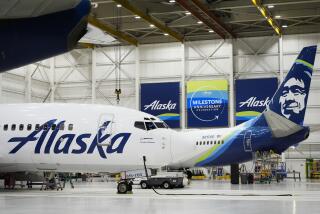Pieces of falling spaceship barely missed people, new evidence shows

Newly released evidence in the investigation of last fall’s crash of an experimental spaceship over the Mojave Desert is raising questions about whether federal aviation regulators are protecting the public as companies launch more rockets.
When Virgin Galactic’s SpaceShipTwo disintegrated on a test flight on Oct. 31, killing one of two pilots, debris rained down over 33 miles of desert northeast of Los Angeles, including some pieces landing dangerously close to the public.
The cockpit section of the rocket ship left a 9-foot-wide crater at the edge of Cantil Road in the northern Antelope Valley — where two trucks had passed each other just seconds before.
Parts of the cabin were found 30 miles away, near the high school in nearby Ridgecrest.
The cockpit debris “came down just 30 or 40 feet behind my truck,” said Ricky Valenzuela of Lancaster.
Valenzuela said he immediately stopped after hearing a loud bang and seeing a cloud of dust, thinking the other truck had crashed. When he stepped out, he found debris surrounding his FedEx truck, he said, and stretching more than a mile along the road.
Other documents released this week show that the Federal Aviation Administration issued launch permits to Scaled Composites, the company that designed and built SpaceShipTwo, despite a safety consultant’s warnings that the firm was violating regulations.
Terry Hardy, the consultant, had worked for the FAA on evaluating Scaled’s permits since 2011, but quit after learning about the SpaceShipTwo crash.
Hardy told investigators that he had been telling the FAA for years that Scaled had not considered all the potential risks of flying SpaceShipTwo. But he felt like he was just “spinning my wheels,” according to a transcript of the interview.
Thomas Martin, a top safety engineer in the FAA’s commercial space office, also complained to investigators, saying that he and other technical staff were often overruled by managers when they questioned Scaled’s operations.
Any questions about Scaled and SpaceShipTwo, Martin said, had to go first to FAA managers, who decided whether they “were too detailed” or “too penetrating.”
Some questions, Martin said, “wouldn’t be presented to Scaled, or they would sit in the management realm and then, all of a sudden, we were there ready to try to issue a permit.”
Martin recalled how one top FAA official had said the relative remoteness of the town of Mojave, where Scaled is based, and the surrounding desert area where the company planned its test flights, was a reason not to oversee the company more aggressively.
Martin summed up the manager’s viewpoint as: “It’s in the middle of nowhere so they didn’t really need to meet the regulations.”
Asked about the comments to investigators, the FAA on Friday defended its actions.
Hank Price, an FAA spokesman, said the agency only issues launch permits “when it is fully confident about an operator’s ability to protect the safety of the uninvolved public and property.”
On Tuesday, federal safety officials harshly criticized the FAA’s oversight of Scaled.
The National Transportation Safety Board, which conducted the investigation, said that the FAA shared the blame for the in-flight breakup of SpaceShipTwo just seconds after it fired its rocket engines.
While investigators found that the copilot had erred by prematurely unlocking the rocket ship’s movable tail, they placed more of the fault on Scaled and the FAA.
The NTSB found that Scaled, which was testing SpaceShipTwo for Virgin Galactic, had failed to consider that a single error by the copilot could lead to the rocket plane’s destruction.
The board also said that the FAA’s evaluations of Scaled’s operations were flawed. Under pressure to quickly approve the company’s permit, the FAA did not ensure that Scaled addressed the possibility of pilot error, the NTSB said.
FAA spokesman Price said the agency was closely reviewing the board’s findings and would issue an official response within 90 days.
SpaceShipTwo was one of three commercial rockets to crash in a span of eight months. Just three days before SpaceShipTwo broke apart, Orbital Sciences’ unmanned rocket carrying cargo to the International Space Station exploded just seconds after liftoff. And in late June, another cargo ship operated by Hawthorne-based SpaceX disintegrated high above Florida’s coast.
As America’s fledgling commercial spacecraft industry launches more rockets, experts say, more failures are expected. But the rising number of launches is also taxing the FAA’s ability to keep up.
In an interview, Hardy, the safety consultant, confirmed his conversation with investigators. He said he had been devastated by the fatal crash of SpaceShipTwo and continued to ask himself, “What more could I have done?”
He said the FAA appeared to be struggling between its duty to protect the public and its stated mission to “encourage, facilitate and promote” American commercial space travel.
“That’s one of the struggles,” Hardy said. “How do you balance those two?”
Congress has prohibited the FAA from regulating space companies with rules similar to those used for the airlines, which have detailed requirements ranging from aircraft construction to pilot qualification.
To compensate, anyone flying on a commercial spacecraft must sign documents noting he or she has been told the risks and accepts them — legal language making it extremely difficult to sue after an accident.
The FAA issued its first permit to Scaled to fly SpaceShipTwo in 2012. Virgin Galactic said then that the permit was issued after Scaled had proved it could keep the public safe.
Agency officials eventually agreed with Hardy that the company was not meeting the regulations, according to interviews. But rather than pushing the company to comply, the FAA simply issued Scaled a waiver from the rules in 2013.
Scaled executives told investigators that they believed from their conversations with the FAA that the company was complying with all rules.
The executives also said they had never asked for a waiver from the rules or been told by the FAA that they needed one.
Investigators said most of the wreckage fell in a five-mile area near Red Rock Canyon State Park. An FBI team surveyed the main impact sites, a report said, including the debris on Cantil Road, which was busier than usual on Oct. 31 because of a highway detour.
The report said that officials found lighter-weight wreckage as far as 33 miles away, including cabin pieces around Burroughs High School in Ridgecrest.
Bryan Auld, the school’s principal, said he wasn’t aware of any large sections landing near the school. But students had found about a dozen smaller pieces, he said, the biggest 3 feet by 2 feet across.
Auld said he called the Kern County sheriff’s office after the students discovered the debris. Officials told him to make sure students didn’t pick up the pieces with their bare hands — a warning he relayed to the entire school, he said.
Twitter: @melodypetersen
ALSO:
Washington’s fight over the budget might shut down the government again
Obama seeks support for Iran deal by reminding allies of Iraq war
Congress approves stopgap bill to keep highway projects going







